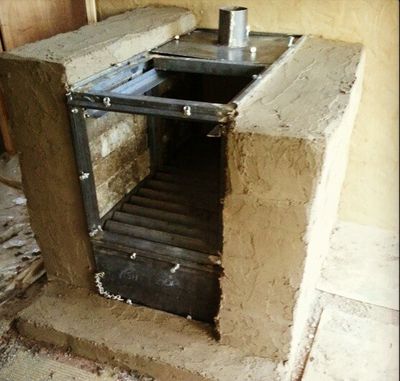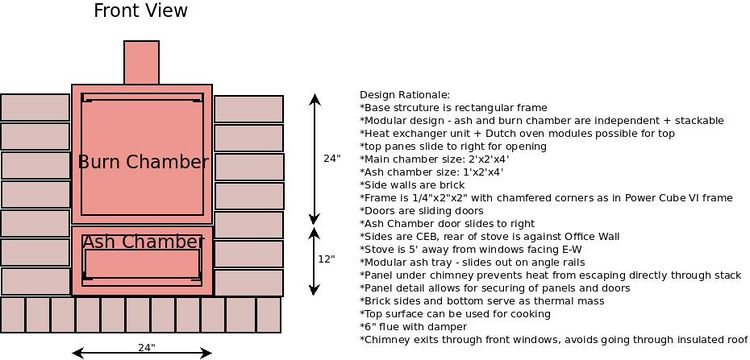Wood Stove with Heat Exchanger
Overview
We have recently designed, built, and installed a long-wood stove for heating our 3000 square foot living structure. The stove has a 2'x2'x4' burn chamber. The stove is a hybrid metal/masonry stove consisting of a 1/4"x2" angle steel frame and 1/8" panels - surrounded from 3 sides by a 1' layer of compressed earth blocks for thermal mass. The stove is modular, such that metal panels can be taken off to modify the stove for applications such as a heat exchanger on top of the stove. Our current intent is to use a 160' long pancake coil of 1/2" schedule 40 black pipe (dimensions of 10" height, 20" diameter) as a heat exchanger. This heat exchanger will be an add-on module. The first purpose of this heat exchanger is to provide a hot water source for a hydronic heating system. This hydronic heating system would use passive, off-shelf, floorboard radiators. We are requesting design bids for designing this system starting from the stove and the heat exchange coil, both of which have been built. We are interested in heating 4 rooms in the house, about 600 sq feet total in area. We are in climate zone 4, continental climate.
The immediate needs are space heating, with the system installed by December 15, 2012. We aim to extend the application of the heat exchanger to run the Hadden Modern Steam Engine for electrical power co-generation - upon reduction of the water feed rate.
Heat Exchanger
Concept: use the heat exchanger to generate hot water for hydronic radiator heating. There are 4 rooms not separated by walls from the stove. We want to feed hydronic heat from the heat exchanger to the 4 rooms. Radiator sizing and all calculations need to be made. Need full design and installation. See Calculations in a section below and see HabLab Build for floor plan. The rooms have 4" fiberglass bats insulation, stick framed, panels, and stucco on each side.
- 160 feet
- Pancake coil configuration, 4" inner hole, 22" OD of pancake
- 1/2" schedule 40 black pipe
- $2/foot materials cost for coil
- See YouTube for Coil Fabrication
Stove
Concept
Notes:
- Design is modular. Heat exchange chamber may be added after stove is operational in passive heat delivery mode.
- Grate under heat exchanger has not been installed in the build. See Stove Fabrication for details of build. The build does contain a 2'x2' panel that can be slid open. It opens by sliding to the front of the stove (door side). this mechanism can be used to control the heat loading onto the heat exchanger.
- All top and front panels can be removed in the actual stove build.
- Sides of stove are made from compressed earth brick and stuccoed.
- Initial runs are successful, and further stove evolution is in progress. There is an issue in that once the stove heats up, the main door panel gets stuck - via thermal distortion?
- Solution thread has been posted on a forum - Stove Forum
Design For Fabrication
Summary:
- Stackable chambers
- Modular faces for configuring as metal or masonry stove
- Modular throughout for addition of functional chambers such as baking oven or heat exchanger
- Faces open by sliding, lock with clamping bolt
Modular Stove Fabrication Procedure
See the build at Modular Stove Fabrication Procedure. The stove looks like this now, flue pipe installed but not shown:
Hydronic Heat Exchange System Design
Requirements:
- Transfers heat to 4 rooms of HabLab - see HabLab Build for floor plan.
- Proper sizing of hydronics radiators. Rooms have framed rooms with 3-1/2" of fiberglass bats insulation
- Heat design: low-energy pumped flow; water reservoir; temperature control; pressure relief; safe design
- Zero user maintenance outside of turning radiators on/off in 4 rooms
- Water is working fluid
Heat Calculations
See https://docs.google.com/spreadsheet/ccc?key=0Ani3apcWYfzDdGhGblBJczdZTVBHVi1GdzduVkotQlE#gid=1
If square footage of hablab is 3000 and average height is 8 feet, the cubic volume is 24,000 cubic feet.
BTU Requirement Formula = cubic footage * .133 * fahrenheit degree change = ~200,000 btu
Expert Review
- October 26, 2012 - from Tom Kimmel, President, SACA - This is basically a good design. What you want is a large volume so you can load it with large chunks or logs of wood. The Startup Flue Pipe is a very good design detail. It can be used for startup and then again as a by-pass if the heat exchangers are getting too hot for any reason. There is one addition I would make and that is to put a thick piece of steel in there about 2 or 3 inches below the top of the stove. It will be a few inches shorter than the stove with the space being near the front door. What you want to do is to get a complete burn of the smoke by making it go up from the fire, run along this piece of hot steel, make the turn and go back over the top of the hot steel and then go through the pancake coils. Many of the better wood stove designs have this kind of a design. It can be made more complex if you want by welding ribs to it for more heat exchange surface and to limit warping from the heat. If there is a problem with smoke going up the chimney after everything is warmed up, then you will want to put some secondary combustion air into the top area to finish burning the smoke. This works better if there is some method for pre-heating the secondary combustion air, with pipes or tubes or something in the fire. Any time you want to make steam just lower the rate of water pumping and it will make steam. Controlling the steam production is a whole another story and there are several ways to do it, none real easy. Good luck. Tom Kimmel
Peer Review
- Zach Dwiel - Are those btu calculations per hour or per day?
- Ben Hansen - Put a Catalytic Converter under the coil, that will keep it from being a drippy tar magnet, and you can focus the heat on to the coil pack. A big burn chamber, line it with firebrick, secondary coil and heat exchange area works well. Model to look at is a simple barrel stove double barrel kit.
- Ben Hansen - catalytic converters in Mother Earth News - also source - Bought stuff from these guys. The "men" link is old, and reference only. Lots of good stuff out there now.
- Darren Hill - I have built a top lit side draft gasifying stove based upon GTZ7 with great help from the designer via the stoves list it is small and appears to require fuel to be processed accordingly (read small, still under testing). I think a larger version could work well with bigger logs. A restricted flue outlet, with alternative path enables heat exchanger to be brought into play aromatically as the burn establishes and volume of output gases exceeds that which the restricted outlet can flow. A suitably sized flue will provide the required draft to provide good combustion. I think I'm right in saying that the more complete combustion achieved in a gasifier stove should drastically reduce any tar deposits on the heat exchanger. --DOHill 14:24, 23 August 2012 (CEST)
- Parker Bonnell - Link to FAQ about catalytic stoves. Guide to the stoves. List of manufacturers and options.
links
- Wood-Fired Hydronic Indoor Furnace - $5k for wood fired hydronic heater (Dead Link)
- Hydronic radiator - $500 - [1]

